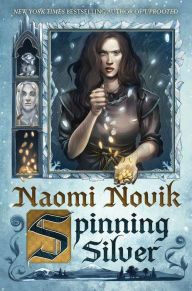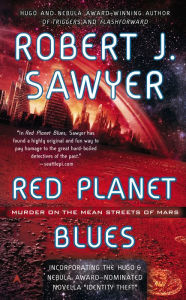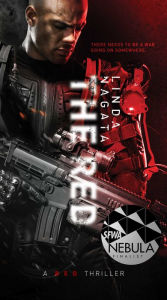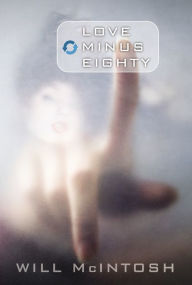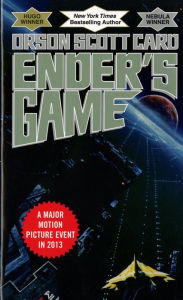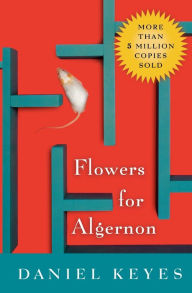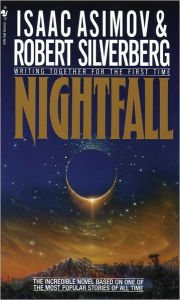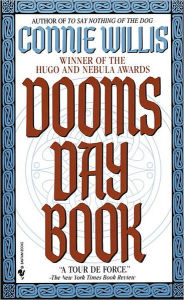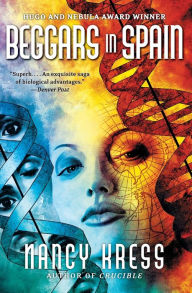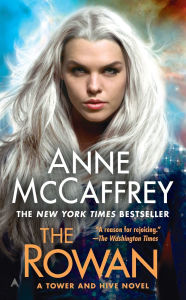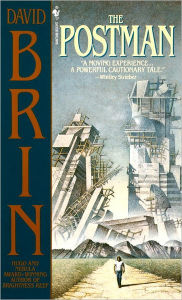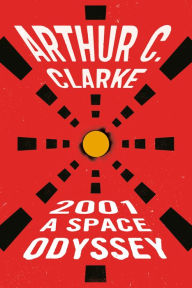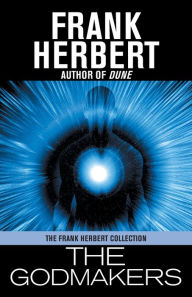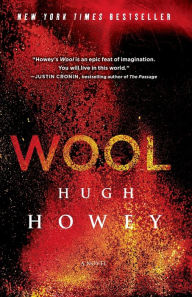15 Science Fiction & Fantasy Novels That Began as Short Stories
 Short stories have always occupied a singular status in the literary world, and are often considered at a remove from novels in terms of conception, structure, and execution. But in sci-fi and fantasy, short stories are also often literary icebergs—tales with so many ideas hiding unseen below the surface that their authors later adapted the into full-length novels. Here are
Short stories have always occupied a singular status in the literary world, and are often considered at a remove from novels in terms of conception, structure, and execution. But in sci-fi and fantasy, short stories are also often literary icebergs—tales with so many ideas hiding unseen below the surface that their authors later adapted the into full-length novels. Here are 15 16 of our favorite examples.
Spinning Silver
Spinning Silver
By Naomi Novik
Hardcover $28.00
Spinning Silver, by Naomi Novik
Readers got their first taste of Novik’s bestselling standalone followup to Uprooted with the same-titled story included in The Starlit Wood, an anthology of “new fairy tales.” Novik transforms thelegend of Rumplestiltzkin, digging into the ugly anti-semitism lurking underneath the fairy tale trappings. The expanded version explores the world of the winter-bringing, fairy-like Staryk and the fate of the young Jewish woman who falls under their influence. It is a novel rich in detail and depth, diving deeper into the themes that made the original story so memorable in the first place, and enriching them via an expanded cast of unforgettable narrators.
Spinning Silver, by Naomi Novik
Readers got their first taste of Novik’s bestselling standalone followup to Uprooted with the same-titled story included in The Starlit Wood, an anthology of “new fairy tales.” Novik transforms thelegend of Rumplestiltzkin, digging into the ugly anti-semitism lurking underneath the fairy tale trappings. The expanded version explores the world of the winter-bringing, fairy-like Staryk and the fate of the young Jewish woman who falls under their influence. It is a novel rich in detail and depth, diving deeper into the themes that made the original story so memorable in the first place, and enriching them via an expanded cast of unforgettable narrators.
Red Planet Blues
Red Planet Blues
Paperback $7.99
Red Planet Blues, by Robert J. Sawyer
Sometimes short stories and novellas don’t need to be expanded and reworked into a novel—sometimes they’re just the beginnings of longer stories. That’s the case with Sawyer’s Red Planet Blues; the first ten chapters of the novel are the novella Identity Theft, pretty much exactly as it originally appeared; Sawyer just continued on with his noirish sci-fi story of private detective Alex Lomax, working cases on the New Klondike colony on Mars.
Red Planet Blues, by Robert J. Sawyer
Sometimes short stories and novellas don’t need to be expanded and reworked into a novel—sometimes they’re just the beginnings of longer stories. That’s the case with Sawyer’s Red Planet Blues; the first ten chapters of the novel are the novella Identity Theft, pretty much exactly as it originally appeared; Sawyer just continued on with his noirish sci-fi story of private detective Alex Lomax, working cases on the New Klondike colony on Mars.
The Red: First Light
The Red: First Light
By Linda Nagata
Paperback $10.99
The Red: First Light, by Linda Nagata
Usually when a writer finishes a short story, that’s it—the idea moves from their heads and onto the page=, and they move on to something else. But when Linda Nagata wrote the short story ‛Through Your Eyes,” featuring hardened mercenary James Shelley in a near-future world with heightened military tech and omnipresent computer surveillance, she knew there was more “there” there. She decided to explore what happened to him after the story ended. The result was The Red: First Light, a novel she chose to release on her own, and which netted her the first-ever Best Novel Nebula nomination for a self-published author (it was later picked up for mass distribution by Simon & Schuster’s Saga Press).
The Red: First Light, by Linda Nagata
Usually when a writer finishes a short story, that’s it—the idea moves from their heads and onto the page=, and they move on to something else. But when Linda Nagata wrote the short story ‛Through Your Eyes,” featuring hardened mercenary James Shelley in a near-future world with heightened military tech and omnipresent computer surveillance, she knew there was more “there” there. She decided to explore what happened to him after the story ended. The result was The Red: First Light, a novel she chose to release on her own, and which netted her the first-ever Best Novel Nebula nomination for a self-published author (it was later picked up for mass distribution by Simon & Schuster’s Saga Press).
Love Minus Eighty
Love Minus Eighty
Paperback
$14.02
$16.00
Love Minus Eighty, by Will McIntosh
McIntosh received acclaim for his short story “Bridesicle,” published by Asimov’s Science Fiction in 2009—it won the Hugo Award for Best Short Story and was a Nebula finalist, which isn’t too shabby. McIntosh took the central concept—a beautiful-but-poor women is kept from death through cryogenic freezing until a wealthy one-percenter decides to claim her as a spouse, thaw her out, and provide her with a cure—and fleshed it out into a richly detailed dystopian story with uncomfortable parallels to our modern day society.
Love Minus Eighty, by Will McIntosh
McIntosh received acclaim for his short story “Bridesicle,” published by Asimov’s Science Fiction in 2009—it won the Hugo Award for Best Short Story and was a Nebula finalist, which isn’t too shabby. McIntosh took the central concept—a beautiful-but-poor women is kept from death through cryogenic freezing until a wealthy one-percenter decides to claim her as a spouse, thaw her out, and provide her with a cure—and fleshed it out into a richly detailed dystopian story with uncomfortable parallels to our modern day society.
Ender's Game (Ender Wiggin Series #1)
Ender's Game (Ender Wiggin Series #1)
By
Orson Scott Card
Introduction
Orson Scott Card
Paperback $6.99
Ender’s Game, by Orson Scott Card
Sometimes transforming a short story into a novel means leaving the original behind. If you dig up a 1977 copy of Analog to read Card’s original short story version of the future Hugo-winning novel, you’ll find it differs quite a bit from the expanded version, though the basic outline and unforgettable final twist are more or less the same. This is also a prime example of a premise so strong, it practically demanded the length and breadth of a novel to really explore its possibilities. The original story is good. The novel is so, so much better.
Ender’s Game, by Orson Scott Card
Sometimes transforming a short story into a novel means leaving the original behind. If you dig up a 1977 copy of Analog to read Card’s original short story version of the future Hugo-winning novel, you’ll find it differs quite a bit from the expanded version, though the basic outline and unforgettable final twist are more or less the same. This is also a prime example of a premise so strong, it practically demanded the length and breadth of a novel to really explore its possibilities. The original story is good. The novel is so, so much better.
A Canticle for Leibowitz
A Canticle for Leibowitz
Paperback $7.99
A Canticle for Leibowitz, by Walter M. Miller, Jr.
The “fix-up” novel—a novel constructed from several previously published short stories, usually with some editing just to paste over discrepancies and add connecting tissue—was commonplace in the early days of science fiction, but aren’t seen nearly as often these days. (Famous examples of fix-ups include The Martian Chronicles and I, Robot). Most fix-ups don’t really fit on this list, as they usually combine many short stories that were already telling a longer overall narrative. Miller’s classic postapocalyptic story of the Catholic Church’s role in helping society rebuild after a nuclear war is a bit different, composed of three long, more or less discreet stories he published in The Magazine of Fantasy and Science Fiction in the 1950s. It remained the only novel Miller published in his lifetime.
A Canticle for Leibowitz, by Walter M. Miller, Jr.
The “fix-up” novel—a novel constructed from several previously published short stories, usually with some editing just to paste over discrepancies and add connecting tissue—was commonplace in the early days of science fiction, but aren’t seen nearly as often these days. (Famous examples of fix-ups include The Martian Chronicles and I, Robot). Most fix-ups don’t really fit on this list, as they usually combine many short stories that were already telling a longer overall narrative. Miller’s classic postapocalyptic story of the Catholic Church’s role in helping society rebuild after a nuclear war is a bit different, composed of three long, more or less discreet stories he published in The Magazine of Fantasy and Science Fiction in the 1950s. It remained the only novel Miller published in his lifetime.
Flowers for Algernon
Flowers for Algernon
By Daniel Keyes
In Stock Online
Paperback $18.99
Flowers for Algernon, by Daniel Keyes
“Flowers for Algernon” was a story close to Daniel Keyes’ heart; most of the characters were based on people from his life. Magazine editors pressured him to change the ending to be happier—to (spoiler!) let the artificially ensmartened Charlie keep his newfound intelligence and live happily ever after. When it won the 1960 Hugo for Best Short Story, Keyes began expanding it into the classic novel, a process that took five years to finish. Publishers then tried to pressure him into changing the ending again, leading Keyes to return at least one advance and receive several other rejections before the book finally saw print. Naturally, he was proven right, and the book is still widely read today, something we probably wouldn’t be saying had Keyes caved to editorial pressure.
Flowers for Algernon, by Daniel Keyes
“Flowers for Algernon” was a story close to Daniel Keyes’ heart; most of the characters were based on people from his life. Magazine editors pressured him to change the ending to be happier—to (spoiler!) let the artificially ensmartened Charlie keep his newfound intelligence and live happily ever after. When it won the 1960 Hugo for Best Short Story, Keyes began expanding it into the classic novel, a process that took five years to finish. Publishers then tried to pressure him into changing the ending again, leading Keyes to return at least one advance and receive several other rejections before the book finally saw print. Naturally, he was proven right, and the book is still widely read today, something we probably wouldn’t be saying had Keyes caved to editorial pressure.
Blood Music
Blood Music
By Greg Bear
Paperback $14.99
Blood Music, by Greg Bear
Often stories expanded into novels reflect evolving concepts. Bear’s original novella-length version of Blood Music, published in Analog in 1983, follows a scientist who injects himself with microscopic living cells capable of learning and their own mental evolution. It has an air of morality pulled right out of a horror story, leaning on the unintended consequences of scientific arrogance. The final novel pushes beyond that into questions about reality itself, and embraces the idea that an unethical, dangerous experiment might actually wind up being humanity’s salvation.
Blood Music, by Greg Bear
Often stories expanded into novels reflect evolving concepts. Bear’s original novella-length version of Blood Music, published in Analog in 1983, follows a scientist who injects himself with microscopic living cells capable of learning and their own mental evolution. It has an air of morality pulled right out of a horror story, leaning on the unintended consequences of scientific arrogance. The final novel pushes beyond that into questions about reality itself, and embraces the idea that an unethical, dangerous experiment might actually wind up being humanity’s salvation.
Nightfall: A Novel
Nightfall: A Novel
By Isaac Asimov , Robert Silverberg
Paperback $7.99
Nightfall, by Isaac Asimov and Robert Silverberg
While it’s typical for story expansion to happen soon after the original publication, that’s not always the case. Isaac Asimov’s short story “Nightfall,” about the population of a planet that experiences sunlight at all times preparing for a coming period of darkness, was published in 1941. The novel version followed in 1990, nearly five decades later, and was written in collaboration with Robert Silverberg. Remarkably, the briefer version of “Nightfall” is far from obscure—it’s usually considered one of the greatest sci-fi stories ever written. The novel is less well-regarded.
Nightfall, by Isaac Asimov and Robert Silverberg
While it’s typical for story expansion to happen soon after the original publication, that’s not always the case. Isaac Asimov’s short story “Nightfall,” about the population of a planet that experiences sunlight at all times preparing for a coming period of darkness, was published in 1941. The novel version followed in 1990, nearly five decades later, and was written in collaboration with Robert Silverberg. Remarkably, the briefer version of “Nightfall” is far from obscure—it’s usually considered one of the greatest sci-fi stories ever written. The novel is less well-regarded.
Doomsday Book
Doomsday Book
Paperback $8.99
Doomsday Book, by Connie Willis
Often a short story isn’t specifically expanded into a novel, but provides the foundational thinking and worldbuilding for a novel. Such is the case with Connie Willis’ classic second novel, Doomsday Book, set in a future first explored in her 1982 story “Fire Watch,” about a future historian who time travels to World War II to participate in protecting St. Paul’s Cathedral, knowing full well that in the future the structure will be destroyed by a terrorist. The story won the Hugo and Nebula that year; a decade later Willis triumphantly returned to the concept with a novel in which a different historian travels back to plague times. Proving just how strong the underlying bones of the story were, Willis won matching Hugo and Nebula awards for the novel as well.
Doomsday Book, by Connie Willis
Often a short story isn’t specifically expanded into a novel, but provides the foundational thinking and worldbuilding for a novel. Such is the case with Connie Willis’ classic second novel, Doomsday Book, set in a future first explored in her 1982 story “Fire Watch,” about a future historian who time travels to World War II to participate in protecting St. Paul’s Cathedral, knowing full well that in the future the structure will be destroyed by a terrorist. The story won the Hugo and Nebula that year; a decade later Willis triumphantly returned to the concept with a novel in which a different historian travels back to plague times. Proving just how strong the underlying bones of the story were, Willis won matching Hugo and Nebula awards for the novel as well.
Beggars in Spain
Beggars in Spain
By Nancy Kress
Paperback $14.99
Beggars in Spain, by Nancy Kress
Like Red Planet Blues, Kress’ expanded version of her award-winning novella presents the original story as part one of a longer work. Three additional sections reveal what happens next, making this more of a continuation than an expansion. Combining economics, genetic engineering, and a breathtakingly epic time scale, it’s easy to see why Kress decided to expand the original tale—while excellent, it was simply too brief to fully explore all the ideas that were bubbling in her head. So too was the novel, in fact—two sequels followed, Beggars and Choosers and Beggars Ride.
Beggars in Spain, by Nancy Kress
Like Red Planet Blues, Kress’ expanded version of her award-winning novella presents the original story as part one of a longer work. Three additional sections reveal what happens next, making this more of a continuation than an expansion. Combining economics, genetic engineering, and a breathtakingly epic time scale, it’s easy to see why Kress decided to expand the original tale—while excellent, it was simply too brief to fully explore all the ideas that were bubbling in her head. So too was the novel, in fact—two sequels followed, Beggars and Choosers and Beggars Ride.
The Rowan (Tower and Hive Series #1)
The Rowan (Tower and Hive Series #1)
Paperback $7.99
The Rowan, by Anne McCaffrey
Whereas many expanded short stories either disappear entirely into their novel versions or serve as the first portion of a larger story, Anne McCaffrey took the story of the Rowan, a lonely Talent known capable of slinging spaceships through space via telekinesis—collected in Get Off the Unicorn in 1977—and formed the larger narrative around it like a pearl.
The Rowan, by Anne McCaffrey
Whereas many expanded short stories either disappear entirely into their novel versions or serve as the first portion of a larger story, Anne McCaffrey took the story of the Rowan, a lonely Talent known capable of slinging spaceships through space via telekinesis—collected in Get Off the Unicorn in 1977—and formed the larger narrative around it like a pearl.
The Postman: A Novel
The Postman: A Novel
By David Brin
Paperback $7.99
The Postman, by David Brin
Short story expansions aren’t always 100 percent successful. The first two parts of Brin’s post-apocalyptic novel appeared as stories in Asimov’s in 1982 and 1984 respectively, and are presented in the novel pretty much unchanged—which might explain why Brin’s study of civilization and the power of symbols starts off really, really strong, then loses a lot of steam as it goes along. It’s not a bad novel by any stretch, but the first two sections are simply better than the concluding material.
The Postman, by David Brin
Short story expansions aren’t always 100 percent successful. The first two parts of Brin’s post-apocalyptic novel appeared as stories in Asimov’s in 1982 and 1984 respectively, and are presented in the novel pretty much unchanged—which might explain why Brin’s study of civilization and the power of symbols starts off really, really strong, then loses a lot of steam as it goes along. It’s not a bad novel by any stretch, but the first two sections are simply better than the concluding material.
2001: A Space Odyssey (Space Odyssey Series #1)
2001: A Space Odyssey (Space Odyssey Series #1)
In Stock Online
Paperback $8.99
2001: A Space Odyssey, by Arthur C. Clarke
Reportedly there were two ways to annoy Arthur C. Clarke. One was to remind him that “The Sentinel,” written in 1948, was submitted to a BBC competition and didn’t even place. The other was to suggest that this story was the basis for the later novel and film adaptation 2001: A Space Odyssey. Clarke felt strongly that while concepts were taken from the story and used in the later versions, the novel and film were not expansions, but their own entities. Considering all three share essentially the same premise, we’re not sure we buy it.
2001: A Space Odyssey, by Arthur C. Clarke
Reportedly there were two ways to annoy Arthur C. Clarke. One was to remind him that “The Sentinel,” written in 1948, was submitted to a BBC competition and didn’t even place. The other was to suggest that this story was the basis for the later novel and film adaptation 2001: A Space Odyssey. Clarke felt strongly that while concepts were taken from the story and used in the later versions, the novel and film were not expansions, but their own entities. Considering all three share essentially the same premise, we’re not sure we buy it.
The Godmakers
The Godmakers
Paperback
$13.49
$14.99
The Godmakers, by Frank Herbert
Again, expanding short stories into novels isn’t always a home run. Herbert’s 1972 novel combines four previously published short stories, and the result is… not Herbert’s best. The first portion of the novel—roughly the first short story he published about a huge galactic empire struggling to reintegrate rim worlds after a devastating war isolated them for centuries—is loaded with pretty solid worldbuilding. After that, it meanders into speechifying that lacks the author’s usual panache.
The Godmakers, by Frank Herbert
Again, expanding short stories into novels isn’t always a home run. Herbert’s 1972 novel combines four previously published short stories, and the result is… not Herbert’s best. The first portion of the novel—roughly the first short story he published about a huge galactic empire struggling to reintegrate rim worlds after a devastating war isolated them for centuries—is loaded with pretty solid worldbuilding. After that, it meanders into speechifying that lacks the author’s usual panache.
One from the comments…
Wool
Wool
By Hugh Howey
Paperback $15.99
Wool, by Hugh Howey
Though it somehow slipped our minds when we posted our original 15-book list, we have to add this one (suggested in the comments), not only because it’s one of the purest examples of a short story being expanded into a novel ever, but because its creation is a fascinating publishing saga in its own right. In 2011, Howey, who was then working as a bookseller, self-published “Wool,” a standalone short story set in a post-apocalyptic world in which the remnants of humanity cling to life in an underground missile silo-turned-habitat. The protagonist is a man sentenced to die for violating the community’s strict laws. His means of execution: venturing up to the toxic surface to clean the cameras that are the silo’s only connection to the world that was. The story’s twists, turns, and shocking ending made it a word-of-mouth sensation, and the buzz prompted Howey to continue the narrative into four more interconnected shorts that were eventually collected into a fix-up novel of sorts. Beyond that, Howey has written yet more books in the wider Silo series, which has long been rumored for a film adaptation.
Wool, by Hugh Howey
Though it somehow slipped our minds when we posted our original 15-book list, we have to add this one (suggested in the comments), not only because it’s one of the purest examples of a short story being expanded into a novel ever, but because its creation is a fascinating publishing saga in its own right. In 2011, Howey, who was then working as a bookseller, self-published “Wool,” a standalone short story set in a post-apocalyptic world in which the remnants of humanity cling to life in an underground missile silo-turned-habitat. The protagonist is a man sentenced to die for violating the community’s strict laws. His means of execution: venturing up to the toxic surface to clean the cameras that are the silo’s only connection to the world that was. The story’s twists, turns, and shocking ending made it a word-of-mouth sensation, and the buzz prompted Howey to continue the narrative into four more interconnected shorts that were eventually collected into a fix-up novel of sorts. Beyond that, Howey has written yet more books in the wider Silo series, which has long been rumored for a film adaptation.
What books can you add to our list? Let us know in the comments.
